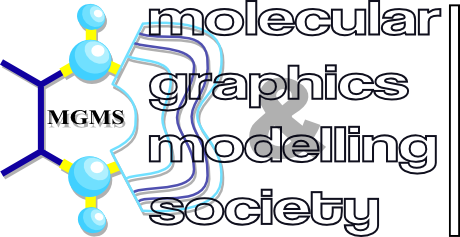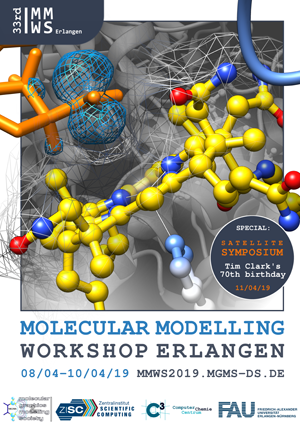Poster Session
Tuesday, April 09th, 15:30
|
| |
| P01 |
Yannic Alber
(Dortmund, Germany) |
Localization of protein-ligand binding thermodynamics |
Abstract |
| |
| P02 |
|
(retracted) |
|
| |
| P03 |
Frank R. Beierlein
(Erlangen, Germany) |
A multi-technique approach to DNA structure determination |
Abstract |
| |
| P04 |
Sebastian Bothe
(Würzburg, Germany) |
Computational approaches to identify small-molecule inhibitors for the N-domain of p97 |
Abstract |
| |
| P05 |
Dušan Ćoćić
(Kragujevac, Serbia) |
Relative stability of homo- and hetero-bimetallic PD(II) and Pt(II) complexes compared to their mononuclear analogues |
Abstract |
| |
| P06 |
Marcus Conrad
(Erlangen, Germany) |
Design and optimization of mimetic peptide probes |
Abstract |
| |
| P07 |
Lukas Eberlein
(Dortmund, Germany) |
Tautomerism of nucleic acid building blocks at ambient and extreme conditions |
Abstract |
| |
| P08 |
Till El Harrar
(Jülich, Germany) |
Comprehensive description of interactions of ionic liquid ions with BsLipA |
Abstract |
| |
| P09 |
David Gnandt
(Freiburg, Germany) |
A dielectric theory view of biomolecular charge transfer |
Abstract |
| |
| P10 |
Sonja C. Herdlinger
(Innsbruck, Austria) |
Pharmacophore-based identification of chemical tool compounds inhibiting 17β-hydroxysteroid dehydrogenase 14 (17β-HSD14) |
Abstract |
| |
| P11 |
|
(retracted) |
|
| |
| P12 |
Christophe Jardin
(Nürnberg, Germany) |
Elucidating zinc binding to the voltage-gated proton channel hHv1 using computer simulations |
Abstract |
| |
| P13 |
Tatu Lindroos
(Computational Chemistry & Biology) |
Digital biology for better antibody-drug conjugates – modelling cell-level pharmacokinetics |
Abstract |
| |
| P14 |
|
(retracted) |
|
| |
| P15 |
Tobias Müller
(Erlangen, Germany) |
Adsorption of organic molecules with high dipole moment on the Au(111) surface |
Abstract |
| |
| P16 |
|
(retracted) |
|
| |
| P17 |
Simon Schäfer
(Erlangen, Germany) |
Computational analysis of human heavy chain CDR3 repertoires: the paradox of tyrosine rich antibodies in memory B cell repertoires |
Abstract |
| |
| P18 |
Lars Schumann
(Dortmund, Germany) |
Analysis of gating behavior and microscopic water structure in small viral K+-ion channels |
Abstract |
| |
| P19 |
Nursel A. Selçuki
(Izmir, Turkey) |
Intermolecular interactions between dopamine and promazine using computational methods |
Abstract |
| |
| P20 |
Cenk Selçuki
(Izmir, Turkey) |
Investigation of the tacrine-saccharin complex: a combined computational and experimental study |
Abstract |
| |
| P21 |
Florian Song
(London, UK) |
A novel methodology for encoding hydrophobic interactions in atomistic graphs constructed from biomolecular structures |
Abstract |
| |
| P22 |
Anselm H.C. Horn
(Erlangen, Germany) |
Role of N-terminal residues for structural stability of triangular Aβ40 fibrillar oligomers |
|
| |
| P23 |
Chetna Tyagi
(Szeged, Hungary) |
Using accelerated molecular dynamics to retrieve conformational ensemble of alamethicin |
Abstract |
| |
| P24 |
Navista S. O. Ujiantari
(Innsbruck, Austria) |
Comparison of the pharmacophore features of agonists and antagonists in β3-adrenergic receptors |
Abstract |
| |
| P25 |
David Wifling
(Regensburg, Germany) |
Basal histamine H4 receptor activation: ligand mimicry by the diphenylalanine motif |
Abstract |
| |
| P26 |
Florian Wullschläger
(Erlangen, Germany) |
Atomistic simulations of chemical graphene exfoliation and carbon nanotube synthesis and of extended defects in bilayer graphene |
Abstract |


